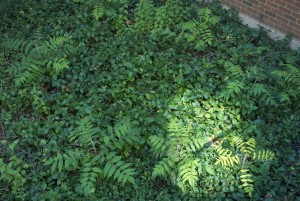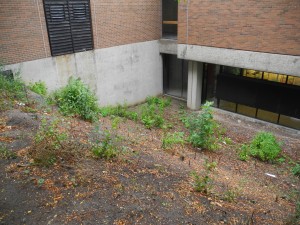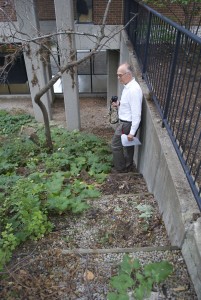Who arrives?
Who invades?
Who is welcome?
Who is not?
When does a plant become a weed?
Since 2012, I have developed an unlikely relationship with Ailanthus altissima, a species of tree more commonly known as the Tree of Heaven. Tree of Heaven is one of the most “successful” global plant species. It lives on every continent except Antarctica and thrives in urban areas. Moreover, it is the evocatively titular tree of Betty Smith’s 1943 novel A Tree Grows in Brooklyn, which recounts the struggle and coming-of-age of an Irish-American in early 20th Century Williamsburgh, Brooklyn. The plant’s thriving in abandoned lots frames the book’s stories of struggle and growth as part of a marginalized immigrant community. The Brooklyn neighbourhoods at the center of the book eventually passed to non-European immigrant communities. Now subject to gentrification, the neighbourhoods are locations of intensifying cycles of change and resistance. Amidst it all, the tree, as in many places, continues to grow.
Indeed, the tree’s very persistence has rendered it a nuisance, and not only in New York. Once a favoured ornamental in Paris and London, Tree of Heaven is not generally sought after these days. Instead, it is often seen as a weed: a plant out of place, a nuisance. In light of this rich history and the plant’s changing identity as part of socio-natural landscapes––and inspired by the scholarly work on plants by Cate Sandilands (2013), Owain Jones and Paul Cloke (2002), Michael Marder (2013), and Richard Maybe (2010), among others––I began to think about how Tree of Heaven could help us to explore the spatial, social, and natural histories of abandoned, out of the way, and “forgotten” spaces in which the tree often thrives.
Following a conference in Toronto in 2013 on urban forestry and political ecologies, at which I presented research that followed the Tree of Heaven to Detroit and Chișinău, Moldova, Professor Anders Sandberg and I started e-mailing back and forth about the tree. He asked if I would be interested in looking for the tree on York’s campus as a way of participating in an Alternative Campus Tour on the themes of colonialism and patriarchy. I enthusiastically agreed and relished the opportunity to take a different look at York’s campus. (Like many, I’m usually rushing to-and-fro, perpetually in transit along weedy railroad tracks.)
On a sunny day in September 2014, Anders and I met to plan a bit for the tour. We went in search of a particular Tree of Heaven that had been catalogued by a census of trees on York’s campus. The tree was supposed to have been in the Founder’s College Quadrangle. I say “supposed to have been” because, when we arrived, it was nowhere to be found. I was neither surprised nor deterred. Unless the tree inhabits private property (and even this is no guarantee), it is often a target for removal, especially since it can hinder the growth of other plants around it through a capacity known as allelopathy, in which the tree releases a signature chemical capable of killing other plants but to which it itself is immune.
As we traipsed around, we met some groundskeepers. We asked if they knew anything about this (or any) Tree of Heaven on campus. Responding with curious interest, they said they didn’t. We pressed on, wending our way through the quadrangle. We stopped in front of a pit garden. Carpeted in green, the garden was home to quite a few young trees that seemed as if they might be Ailanthus. We got down into the garden and I plucked a leaf, rubbed it vigorously between my hands, and cupped the crushed remnants to my nose. I did this because one of the tell-tale signs of the male Tree of Heaven is that its leaves and flowers produce a strong smell; some say they smell like rotten peanut butter and others say they smell like semen.
“Must be Sumac,” I said, since the tree lacked the telltale smell and, on closer inspection, had a slightly different form than that of Ailanthus. Though Sumac has a very similar leaf and pom-pom pattern to the Tree of Heaven it is, unlike its weedy cousin, a species considered native to Canada. In fact, when Ailanthus was first being named and catalogued by European colonial botanists, it was frequently mistaken for Sumac (Hu 1979). When searching for Tree of Heaven, it is better trust your nose more than your eyes. Mistaken identity is always a risk.

Sumac tree saplings at Founders Square. They are often mistaken for the Tree of Heaven. Photo credits: The author.
Both a bit perplexed by the absence of the tree, we started to talk about an article that had recently been published in the York University Magazine, a glossy promotional “advertorial” style publication that features students, staff, and employees in stories aimed at marketing York to a broad, even international, audience. The article focused on John Wilson, who, at the time, was heading up an effort to combat an invasive species of beetle, the Emerald Ash Borer, that has been threatening Toronto’s trees for some time now. We thought that Wilson might know something about the tree, so I called him.
In our brief phone conversation, Wilson said he was not aware of either that particular tree or the census which suggested it would be in the Founders College Quadrangle. He vowed to look into it for me. In an e-mail exchange the next day, Wilson said that, based on the locations, the survey was likely completed just after the construction of the Chemistry Building in the late 1990s. He also shared two photos of a Tree of Heaven near the Executive Learning Center; a sprightly young thing sidled up next to the shiny new building. While Wilson betrayed little sympathy for the tree––which, as it turns out, is no longer there––he did say that even a Tree of Heaven is better than no tree at all.
“They have a place,” he assured me.
“Why might it have been torn out?” I asked.
Wilson assured me that York has no particular policy that targets the Tree of Heaven. He paused for a beat and then followed up: “Neither does it buy them to plant on purpose, obviously.”
Indeed, this much was obvious as, in the concluding part of my walk with Anders, just as we thought we wouldn’t find a Tree of Heaven to guide us on the tour, I spotted one tucked away in a sunken hillside abutting the breezeway which connects Vanier College with Founders.

A Tree of Heaven located by the breezeway between Founders and Vanier Colleges. Photo credits: The author.
I was giddy with excitement at seeing this familiar friend among tangled and neglected vegetation. We found a haphazard stairway and ambled down to investigate. As we negotiated the stairs, I snapped some photos.
“Stairway to Heaven,” we joked.
There, among forgotten remnants, a Tree of Heaven stood, reaching for the sky. It was quite clear that this tree had not been planted intentionally, especially considering that, only a few months later, when I came to check on the tree, it was gone. Clearly, the particular tree we found that day was neither a part of the official record nor of the institutional memory of York.
Indeed, in its strategically clandestine and inauspicious placement, the tree stood as something of a contrast to a young English Oak, Quercus rober, planted several years ago in the Founders Quadrangle. Anders and I had stood in front of that tree only moments earlier trying to figure out the mystery of the Tree of Heaven. The young Oak is marked with a commemorative plaque. It was planted to honor the memory of Qian Liu, an international student from Beijing who was murdered on April 15, 2011, in the Tribute Homes’ Village, a house subdivision built on University lands sold to a private developer (Tancock 2011). On April 28, 2011, two weeks after Liu’s murder, friends and family gathered to plant the tree. Following the dedication ceremony, York’s President and Vice-Chancellor, Mamdouh Shoukri, said, “A tree inspires energy, faith, devotion, and courage and represents life as well as the passage of time...The tree will forever commemorate Qian Liu, especially as it grows into something majestic.” (Tancock 2011).

English Oak planted at Founders College in memory of a murdered Chinese student. Photo credits: The author.
The tree’s location at Founders speaks to complex layers of arrival, travel, place, memory, and mourning. Founders was the first college established on Keele Campus. One layer: It is named in honour of the white, heterosexual men who established the University. Another layer: In the College’s residence, there are seven houses, each of them named for a painter of the Group of Seven, the seven white men whose landscape paintings were foundational in promoting a nationalism based on Canadian nature (but in fact also presenting that vast nature and its apparent emptiness, its “ripeness” for exploitation, exploration, and settler colonial expansion). Yet another layer: Founders is the location of the York University English Language Institute (YUELI), which has provided English-language instruction to foreign students at York since 1985, where Liu had been studying for seven months. Callum MacKechnie, the director of YUELI, also spoke at the dedication ceremony, saying that, unlike the irreversible loss of human life, the tree would be “something permanent and beautiful”; something which would preserve Liu’s memory. The story reporting on the ceremony closed by observing that, “As they filed inside, Qian’s friends and those who gathered for the occasion did not move, but stood silent, before this straight and sturdy young oak” (Tancock 2011).
Why an English oak? Quercus rober (oak + strength/hard timber) originates in Europe, Anatolia, and the Caucasus. How did it arrive here on the York campus? Perhaps it has something to do with imperial connections, the oak being the national tree of England. Or, it may be a reflection of the presence of an oak on York University’s crest. Eric Aldwinckle, the designer of the crest, was himself inspired by the University of York’s crest in England, though not by an oak but by a white rose. What’s more, Aldwinckle gave name to the street address, 27 Aldwinckle Heights, in the Tribute house development, where Qian Liu was murdered. The oak is also a symbol of money, something that figures prominently in the story about YUELI.
In 2005, the University took the decision to move YUELI to Founders. The relocation sent a strong symbolic message that the first college at York would also be the source of York’s revitalization through internationalization and recruitment of students from around the world and, in particular, from East Asia, where a burgeoning middle-class increasingly sees value in sending young people to North America for university education. What’s more, the University is constantly seeking international students to burnish its reputation as a so-called “global thought leader.”
The arrival of international students creates significant financial gain for the university. The University’s aggressive recruiting efforts signal the importance of the monetary dimension, witnessed, for example, by the no doubt costly trip that Liberal Arts & Professional Studies’ Dean Martin Singer took to Beijing and Hong Kong in 2013. His was the third trip by a university official since 2010. If you search for “Beijing” on York’s website, there are 2,940 results. Clicking around, you may note the excited tone as you become immersed in the work of “internationalization” through photos of smiling delegations meeting around board room tables. You can read research, studies, and internal documents that make the case for opening and exploring this “new frontier.” Millions have been spent on building partnerships that many Keele Campus students must scarcely notice as they labour away, sitting on the floor of an overcrowded library, perhaps sneaking bites of overpriced sandwiches.
These internationalization efforts also have less obvious costs. The Tribute Village housing development, for example, was meant to attract “respectable” middle-class families. However, it also enticed small-scale landlords who subdivided houses into rental units for students. Boasting relatively cheap rent and flexible leases, the units are typically small and sub-standard, lending new meaning to the compromises of “student safety.” Faced with high differential tuition fees, many international students, like Liu, have opted and continue to opt to live in The Village. This has, in part, boosted the University costs for so-called safety and security services. It has also put financial pressure on the Founders Residence, which closed for a time due to lack of residents, only to open again after Liu’s murder.
While the University expands its recruitment of students in Asia as a revenue-seeking strategy, the Tree of Heaven is, shall we say, pursued less vigorously. Search “A. altissima” and you get seven results, only two of which pertain to the tree. One is the tree inventory spreadsheet that led us to Founders College in the first place. Main Page [slash] EcoData [at] York [slash] Tree Species. Line after line, name after name arrivals and invaders. Tree of Heaven is one resident of York that is most certainly not invited, but is, at most, tolerated. As Wilson put it, they probably just “made their way here,” doubtless aided along by the strong wind of institutional ambivalence. In a recent York University Keele Campus tree census, the Tree of Heaven is not even mentioned as an inventoried species (Keele Campus Tree Inventory, 2015).
When we look for Tree of Heaven, what are we looking for? What are we naming when we invoke the heavens to find it? Are we looking for the industrious species, brought not only by white Europeans to botanical gardens aimed at exploiting and classifying the “resources" of colonized lands and people, but also by Chinese labourers who built transcontinental railroads in the so-called new world of America, including in Canada? Following the Chinese Immigration Act of 1885, all people arriving from China were charged a racist “head tax,” meant to discourage migration following the construction of the Canada Pacific Railway, during which at least one thousand labourers died. An official apology came some 121 years later in the form of a speech to Parliament in which Prime Minister Stephen Harper (2006) noted that, “…from the moment that the railway was completed, Canada turned its back on these men.”
Or are we looking for the present generation of Chinese students who come from the land of the Tree of Heaven, and whose high differential tuition fees are great sources of revenue for Canadian universities? Here we cannot forget that, in a show of their intentions, the University even went so far as to describe an $825 fee imposed on international master’s students as a “head tax” (Rollman 2014; “Media Advisory – Close the Gap”). Clearly, the university is seeking ways to close its financial gaps, of helping it become a profitable business. For this, international students have a specific and prescribed role to play in filling out the aesthetic, financial, and institutional quotas established by the University’s neoliberal, not to mention racist and neo-colonial, agenda.
But what happens if students––or if Trees of Heaven––don’t behave the way they “should”? Stay where they are placed? Grow according to restrictive standards? Accept the ever present discourse of limited resources? Put their heads down to work and turn the other way when the University censors speech, increases racial profiling and police presence on campus, or continues to create divisions and hierarchies among students? What if they become “unruly”? In 2015, for example, when the University tried to increase International Tuition Fees by 50%, a move that was hotly contested, a labour strike by the University’s Teaching Assistant and part-time instructors, represented by the Canadian Union of Public Employees, Local 3903, reversed the decision. The University is now shirking its obligation and waging a protracted legal battle to fight the return tuition fees to lower levels.
And as for the Tree of Heaven? After having been extracted from site at the breezeway between Founders and Vanier Colleges a few months ago, a few sproutlings are now precariously re-establishing themselves in the very same place and elsewhere.

A few saplings of the Tree of Heaven at the far corner and along the concrete wall are precariously growing by the breezeway connecting Vanier and Founders Colleges. Photo credits: L. Anders Sandberg
Will it survive, maybe even thrive, in the cracks and crevices that it manages to carve out for itself? Can you keep your senses tuned to the tree’s presence or absence? What does it ask us to consider when we listen very carefully?
How did I arrive here?
How did I come to be here?
Am I an invader?
What makes me welcome?
Am I desirable for this ecology?
Why or why not?
Can I ever be naturalized?
Can I survive?
Can I thrive?
On whose terms?
Whose heaven is this?
References
“A Boring Story: York University Experts Are Waging a War on an Invasive Exotic.” YorkU: The Magazine of York University. Fall 2014: 8–9.
Harper, Stephen. 2006, June 22. “Address by the Prime Minister on The Chinese Head Tax Redress.” Office of the Prime Minister of Canada. < http://www.pm.gc.ca/eng/news/2006/06/22/address-prime-minister-chinese-head-tax-redress >
Jones, Owain, and Paul J Cloke. 2002. Tree Cultures: the Place of Trees and Trees in Their Place. Oxford, UK: Berg Publishers.
Keele Campus Inventory. 2015. Accessed 26 July at http://www.arcgis.com/home/webmap/viewer.html?webmap=5a443fd0617248be8113c5f3166ad1c4&extent=-79.5197,43.7672,-79.488,43.7802
Marder, Michael. 2013. Plant–Thinking: A Philosophy of Vegetal Life. New York City, NY: Columbia University Press.
“Media Advisory – Close the Gap! Students Outraged as York University Further Exploits International Students.” CNW. April 24, 2014. < http://www.newswire.ca/en/story/1343917/media-advisory-close-the-gap-students-outraged-as-york-university-further-exploits-international-students>
“New York Voices: Joel Sternfeld.” YouTube Video. 6:03. Posted by Friends of the High Line, March 4, 2009. < https://www.youtube.com/watch?v=lNzr7g8FQgk>
“YUELI celebrates 20 years of excellence.” yFile. October 28, 2005. < http://yfile.news.yorku.ca/2005/10/28/yueli-celebrates-20-years-of-excellence/>
Hu, Shiu Ying. 1979. “Ailanthus.” Arnoldia 39(2): 29–50.
Rollman, Hans. 2014, April 30. “York University needs to call off its war on international students.” Rabble.ca. < http://rabble.ca/blogs/bloggers/views-expressed/2014/04/york-university-needs-to-call-its-war-on-international-studen>
Sandilands, Catriona. 2013. “Dog Stranglers in the Park?: National and Vegetal Politics in Ontario's Rouge Valley.” Journal of Canadian Studies 47(3): 93–122.
Tancock, Martha. 2011, May 2. “A tree is planted for Qian Liu.” yFile. < http://yfile.news.yorku.ca/2011/05/02/a-tree-is-planted-for-qian-liu/




